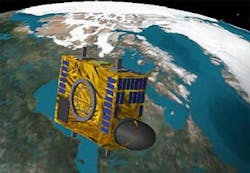e2v image sensors launched into space
On February 25, 2013, imaging sensors from e2v (Chelmsford, UK) were launched into space on board NEOSSat, a Canadian microsatellite mission to discover and determine orbits of Near-Earth Objects (NEOs) that cannot be efficiently detected from the ground.
NEOSSat will circle the globe once every 100 minutes, scanning the area near the Sun, to pinpoint asteroids and comets that orbit in the inner part of the Solar System and then monitor their trajectories.
The microsatellite will also sweep the skies, performing research on satellites and space debris as part of Canada’s commitment to keeping orbital space safe.
NEOSSat is jointly funded by the Canadian Space Agency (CSA) and by Defence Research and Development Canada (DRDC), an agency of the Department of National Defence.
The imager on board NEOSSat consists of two e2v CCD47-20 sensors. They have a mid-band coating for optimum quantum efficiency and use a frame transfer system for faster readouts of captured images, allowing e2v to avoid using a shutter. The detector arrays are comprised of 1024 x 1024 pixels with a 13µm pitch, making them suitable for monitoring orbital space.
Related articles from Vision Systems Design that you might also find of interest.
1. e2v sensors capture images from space
The Centre National d'Etudes Spatiales (CNES) Earth observation satellite Pléiades 1B has captured its first images using e2v's (Chelmsford, UK) imaging sensors.
2. Imaging sensors launched into space
On 23rd March 2012, imaging sensors from e2v (Chelmsford, Essex, UK) were launched into space onboard the European Space Agency’s (ESA) Edoardo Amaldi spacecraft, the third Automated Transfer Vehicle (ATV) to be sent to the International Space Station (ISS).
3. Image sensors to spot objects in the Kuiper Belt
Imaging sensor maker e2v (Chelmsford, UK) has been awarded a contract by the Academia Sinica Institute of Astronomy and Astrophysics (ASIAA) in Taiwan to supply a set of 40 large-area CMOS imaging sensors for three ground-based telescopes as part of the Transneptunian Automated Occultation Survey (TAOS II).
-- Dave Wilson, Senior Editor, Vision Systems Design
